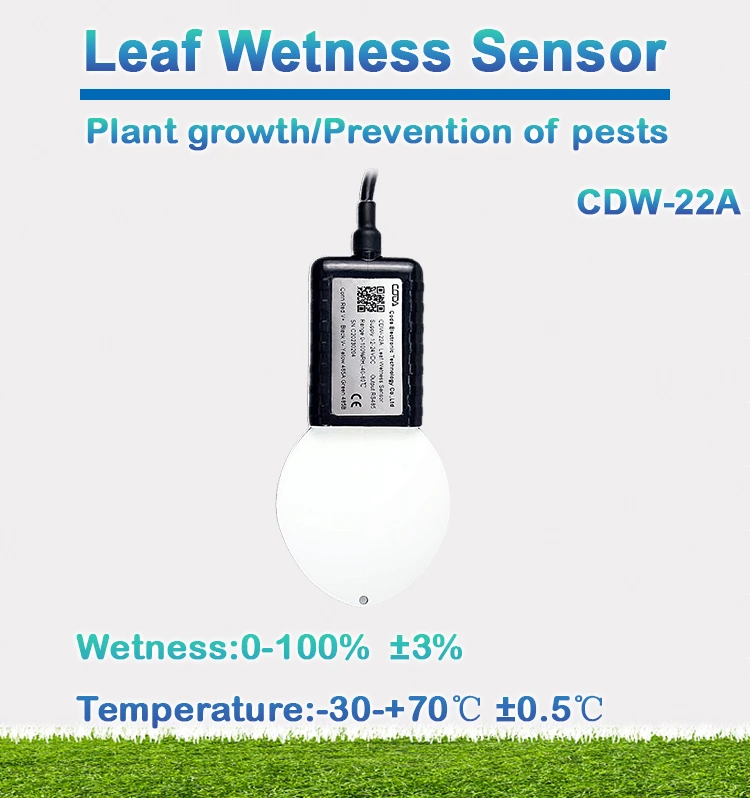what is the main leaf wetness sensor
In the intricate realm of plant physiology and environmental monitoring, leaf wetness sensors play a crucial role. They give important information about moisture on plant leaves. This impacts many biological processes, such as photosynthesis, transpiration, and the spread of plant diseases.
Knowing the main types of leaf wetness sensors can help you choose the best one for your needs. This includes research on farming, gardening, and the environment.
Electrical Resistance – Based Leaf Wetness Sensors
One common type of leaf wetness sensor works based on electrical resistance. These sensors typically consist of two or more electrodes placed in close contact with the leaf surface.
When the leaf is dry, the electrical resistance between the electrodes is high. Air fills the gaps between the electrodes and the leaf. This is because air does not conduct well.
When water droplets form on a leaf during rain, dew, or irrigation, they help conduct electricity. This lowers electrical resistance.
The measurement team checks the change in resistance. They then turn this into a signal that shows how wet the leaves are. This type of sensor is simple in design.
It can give real-time data on leaf wetness. Farmers often use it on farms to check the risk of fungal diseases.
Many fungal pathogens need a specific amount of leaf wetness to infect plants. Farmers can use electrical resistance sensors to check leaf wetness.
This helps them predict disease outbreaks. This helps them use fungicides at the right time. This reduces crop losses.
Capacitive Leaf Wetness Sensors
Capacitive leaf wetness sensors work based on capacitance. These sensors have a structure like a capacitor. The leaf surface and the sensor’s electrodes are the two plates. The air or water between them acts as the dielectric.
The dielectric constant of water is not the same as that of air. When the leaf is dry, the dielectric constant is low. This means it has a specific capacitance value.
As water builds up on the leaf, the dielectric constant goes up. This causes a change in the sensor’s capacitance.
An electronic circuit detects the change in capacitance and translates it into a measurement of leaf wetness. Capacitive sensors have many benefits. They are very sensitive and can give accurate measurements for different levels of leaf wetness.
They are also less affected by things like electrode fouling than electrical resistance-based sensors. This makes them more reliable for long-term use in the field. In ecological research, capacitive leaf wetness sensors help study the microclimate around plants. They show how this microclimate affects the water balance of the leaves.
Optical Leaf Wetness Sensors
Optical leaf wetness sensors use light to measure how wet leaves are. These sensors usually send light to the leaf surface. They then detect how much light reflects back or passes through the leaf and water. When the leaf is dry, light interacts with its surface in a special way.
A certain amount of light reflects or passes through. When water is on the leaf, the droplets change the way the surface looks. This changes how much light reflects or goes through.
For instance, some optical sensors use infrared light. Water on the leaf can change how it absorbs and reflects infrared light. The sensor can find out how wet the leaves are by looking at these changes.
Optical sensors are non-invasive. This means they do not touch or harm the leaf. This is helpful for monitoring delicate plant species. It is also useful for long-term measurements that need to be undisturbed.
They are also helpful in automated weather stations and environmental monitoring networks. They provide continuous and accurate data on leaf wetness conditions.
Piezoelectric Leaf Wetness Sensors
Leaf wetness sensors operate based on the piezoelectric effect. Piezoelectric materials create an electrical charge when they are under mechanical stress.
Water droplets on the leaf can cause vibrations. They can also change the stress on the piezoelectric material in these sensors. The system changes these mechanical movements into an electrical signal. This signal shows how wet the leaves are.
Piezoelectric sensors are not as common as the other types mentioned. However, they have unique benefits in some applications. They are very sensitive to small amounts of water on the leaf.
They can respond quickly, which makes them useful for detecting changes in leaf wetness right away. However, they can be more complex and costly to make and maintain than some other sensor technologies.
conclusion
There are four main types of leaf wetness sensors. These are electrical resistance, capacitive, optical, and piezoelectric sensors. Each type has its own features and benefits. They also have the best ways to use them.
These sensors help keep crops safe from diseases. They also help us see how plants connect with their surroundings.
They also watch the microclimate. This information is important for managing farms and ecosystems better. As technology keeps changing, we can expect better leaf wetness sensors. These sensors will help us check moisture on plant leaves more accurately and easily.
